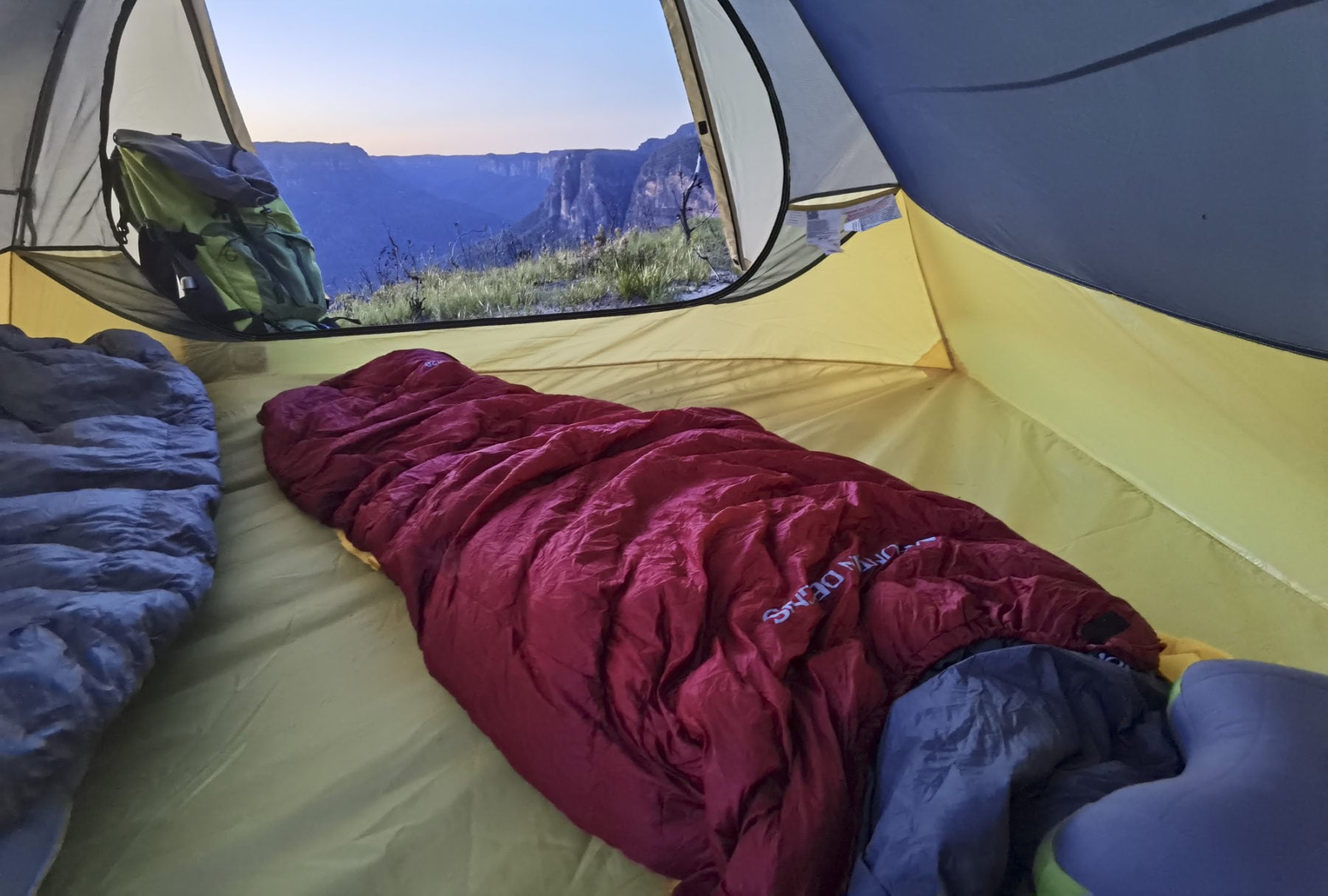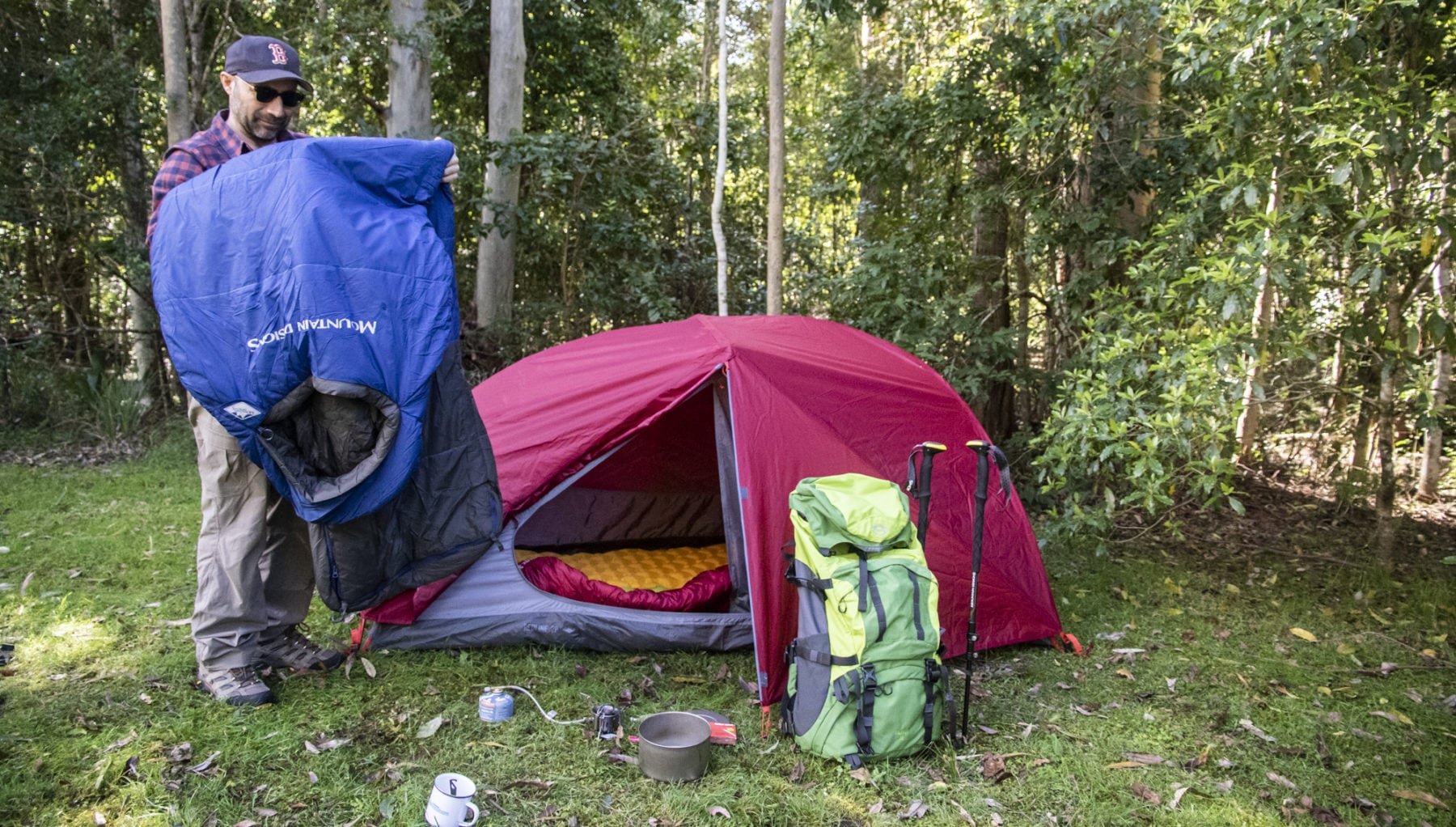Nothing beats a good night’s sleep in the wilderness. After a fun day outdoors, a warm sleeping bag and comfortable air-mat will ensure you’re fully rested overnight and ready to roll again for the next day’s adventure. Here’s how to create the ultimate outdoor bedroom…
The sleeping bag: more than you think
Sleeping bag choice will be heavily influenced by how your body works; whichever one does the best job of keeping you warm and comfortable will be the bag you need. Your choice will also be influenced by the conditions and terrain in which you will be using the sleeping bag. For the snow-covered alpine regions in winter, you don’t want a three-season sleeping bag. Conversely, for most of us Aussie outdoor fanatics, a three-season bag, such as the Mountain Designs Travelite 320 (read our review here) is the ideal one-bag-to-rule-them-all when it comes to the activities most of us enjoy throughout the year.
A sleeping bag ain’t a simple piece of gear, either. There are myriad components hidden under that shiny outer fabric that you need to know about, including the shape, the type of fill (down or synthetic), the loft figure (yep, we’re getting techy now!) and, of course, the value-for-money equation when balanced against how often you will be using the bag. And don’t get us started on the humble self-inflating mat. Instead, read on for our hot tips on the perfect sleeping bag and mat purchase…
Sleeping bag style is important

Sleeping bag style (the shape in which it is cut) plays a major role in final choice. For the best warmth retention capabilities, a mummy-cut bag is the best option. This is due, as the name suggests, to its body-hugging shape/cut that leaves minimal empty space inside the bag for a human’s body to warm up, thus retaining heat more effectively. Conversely, these tightly shaped bags can be restrictive – restless sleepers need not apply – so are most used for things like alpine climbing and cold-condition adventures, where every additional degree of warmth is much appreciated.
The semi-rectangular sleeping bag is the most popular style as it combines the more spacious characteristics of a rectangular bag, with just the right amount of ‘free space’ to allow some movement for the sleeper, without too much dead space meaning it takes a lot to warm up inside it. There are child-specific sleeping bags on the market, such as the Spinifex Kid’s Keira, and, for those with children aged from around three to 12, are the go-to for a happy night’s camping.
Be materialistic
What material is used to fill a sleeping bag governs its warming characteristics. The majority of sleeping bags use synthetic fibre (nylon or a variation of) for the outer shell, but buyers have two choices for the inside fill material: down or synthetic.
For decades, down-fill bags have been the preferred option due to down’s better warmth for weight performance, and it packs down smaller. Down-fill bags will generally offer a longer ‘life’ compared to synthetic, and it is more resistant to odour retention. It does have its negatives, though: if a down-fill sleeping bag gets wet, it will just be wet and cold – it will not offer any warmth at all. There are sleeping bags with a water-resistant down fill now available on the market, but they are very expensive.
If most of your camping is out of a vehicle, a sleeping bag’s packed size and weight is less important, though, making a synthetic-fill bag, such as the Mountain Designs Overlander 300, a great – and more affordable – option. Synthetic fill technology has advanced incredibly in the past decade, to the point now where a synthetic-fill bag is a viable option for even the fussiest sleepers; the latest synthetic fill compresses down quite compact, while offering close to the warming capability of down, albeit still with a slight weight disadvantage. The other advantage of synthetic-fill bags is they will retain some warmth even when wet, unlike down (unless you opt for the very expensive water-resistant down bags).
The sleeping mat

As well as a warm sleeping bag, the other big influence on your outdoor nocturnal comfort is the sleeping mat. Sleeping mats are available in solid-foam versions or the more common (and more luxurious) inflatable air mats.
Inflatable sleeping mats – whether self-inflating or via a pump (or your lungs) – are more expensive than the solid-foam mat but raise comfort levels significantly. There are many variants, with some offering different types of insulation (natural, in the form of down, and synthetic), while others offer reflective material inside the mat that is claimed to reflect and retain your body heat. Then there’s the range of mat heights on offer; you can find mats with heights ranging from 25mm to 75mm for hiking, paddling and bikepacking, with the Mountain Designs Airlite 5.5 a great option. For car-camping based mats, the Dune 4WD series (available in single, double and queen sizes) topping the comfort levels with a 100mm thick mattress and a robust build quality.
Don’t skimp on a cheap mat; these budget models don’t hold their shape and fail quite easily due to fragile construction. This does not mean you have to pay a fortune for a sleeping mat: buying from a well-regarded brand (Mountain Designs, Dune 4WD, Spinifex, Black Wolf) that has been producing air mats for years is the safest bet and most of these brands have a wide range of models with pricing that is more palatable. For most Aussie conditions, a three-season mat of around 50-75mm thickness is more than enough.
One other option – and a great one if you have the storage space in your vehicle – is a camp stretcher. Well, really, it’s a fold-up bed that gets the sleeper off the ground and can offer more comfort – but they are fantastic if you are planning on camping at one location for more than a few nights – we’ve used the Dune 4WD Quick Lock stretcher for a couple of big outback trips and it’s been brilliant. The other advantage is that, due to these cots being higher off the ground, it’s easier to get up/down from bed. Or is that just our, ahem, slightly advanced age talking there…
The final word

The best advice when looking at a sleep system is to look at both components – the sleeping bag and mat – as one unit, and especially regarding warmth and comfort, as the two ‘work together’ to provide these. This allows you to potentially get away with a slightly less-warm rated sleeping bag if the air mat you choose has a slightly higher warmth rating. (It is worth remembering that the majority of your body heat does not, in fact, dissipate through your head, but through the mat to the ground below.)
Once you’ve sourced your sleep system from your local Anaconda store – and added it all to your camping kit – that’s when the real fun starts; with the assurance that your carefully chosen outdoor bed set-up will offer that comfortable night’s sleep, and you’re revitalised for the next day’s adventure!




